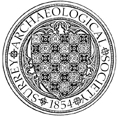Former Stanwell Centre, Short Lane, Stanwell
A watching brief was carried out by TVAS on the construction of a sports ground and pavilion, for Ashford Sports Club Ltd, in an area where a ring ditch has been noted on aerial photos. Most of the groundworks were shallow, the limited deeper works revealed only levels of modern dumping. A few pieces of struck flint were recovered during the watching brief. (319)


